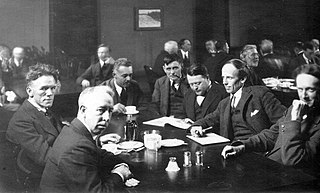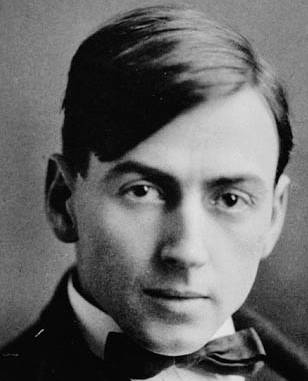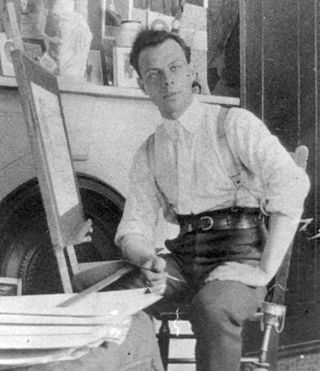
The Group of Seven, once known as the Algonquin School, was a group of Canadian landscape painters from 1920 to 1933, with "a like vision". It originally consisted of Franklin Carmichael (1890–1945), Lawren Harris (1885–1970), A. Y. Jackson (1882–1974), Frank Johnston (1888–1949), Arthur Lismer (1885–1969), J. E. H. MacDonald (1873–1932), and Frederick Varley (1881–1969). A. J. Casson (1898–1992) was invited to join in 1926, Edwin Holgate (1892–1977) became a member in 1930, and Lionel LeMoine FitzGerald (1890–1956) joined in 1932.

Thomas John Thomson was a Canadian artist active in the early 20th century. During his short career, he produced roughly 400 oil sketches on small wood panels and approximately 50 larger works on canvas. His works consist almost entirely of landscapes, depicting trees, skies, lakes, and rivers. He used broad brush strokes and a liberal application of paint to capture the beauty and colour of the Ontario landscape. Thomson is considered by many Canadians as the archetypal painter, and his later work has heavily influenced Canadian art – paintings such as The Jack Pine and The West Wind have taken a prominent place in the culture of Canada and are some of the country's most iconic works. His accidental death by drowning at 39 shortly before the founding of the Group of Seven is seen as a tragedy for Canadian art.

Cornelius David Krieghoff was a Dutch-born Canadian-American painter of the 19th century. He is best known for his paintings of Canadian genre scenes involving landscapes and outdoor life, which were as sought after in his own time as they are today. He painted many winter scenes, some in several variants.

Arthur Lismer, LL.D. was an English-Canadian painter, member of the Group of Seven and educator. He is known primarily as a landscape painter and for his paintings of ships in dazzle camouflage.

Alexander Young Jackson LL. D. was a Canadian painter and a founding member of the Group of Seven. Jackson made a significant contribution to the development of art in Canada, and was instrumental in bringing together the artists of Montreal and Toronto. In addition to his work with the Group of Seven, his long career included serving as a war artist during World War I (1917–19) and teaching at the Banff School of Fine Arts, from 1943 to 1949. In his later years he was artist-in-residence at the McMichael Canadian Art Collection in Kleinburg, Ontario.

Lawren Stewart Harris LL. D. was a Canadian painter, best known as one of the founding members of the Group of Seven. He played a key role as a catalyst in Canadian art, as a visionary in Canadian landscape art and in the development of modern art in Canada.

Franklin Carmichael was a Canadian artist and member of the Group of Seven. Though he was primarily famous for his use of watercolours, he also used oil paints, charcoal and other media to capture the Ontario landscapes. Besides his work as a painter, he worked as a designer and illustrator, creating promotional brochures, advertisements in newspapers and magazines, and designing books. Near the end of his life, Carmichael taught in the Graphic Design and Commercial Art Department at the Ontario College of Art.

James Edward Hervey MacDonald (1873–1932) was an English-Canadian artist, best known as a member of the Group of Seven who asserted a distinct national identity combined with a common heritage stemming from early modernism in Europe in the early twentieth century. He was the father of the illustrator, graphic artist and designer Thoreau MacDonald.

The Jack Pine is a well-known oil painting by Canadian artist Tom Thomson. A representation of the most broadly distributed pine species in Canada, it is considered an iconic image of the country's landscape, and is one of the country's most widely recognized and reproduced artworks.

William Cruikshank was a British painter and the grand-nephew of George Cruikshank. He studied art at the Royal Scottish Academy in Edinburgh, at the Royal Academy School in London with Frederic Leighton and John Everett Millais, and in Paris at the Atelier Yvon. His last studies were interrupted by the Franco-Prussian War.

David Milne was a Canadian painter, printmaker, and writer. He was profoundly different from most of his Canadian art contemporaries, especially Tom Thomson and the Group of Seven. He is sometimes referred to as the Master of Absence and known for his ability to reduce a painting to its bare essentials.

The West Wind is a 1917 painting by Canadian artist Tom Thomson. An iconic image, the pine tree at its centre has been described as growing "in the national ethos as our one and only tree in a country of trees". It was painted in the last year of Thomson's life and was one of his final works on canvas. The painting, and a sketch for the painting, are displayed at the Art Gallery of Ontario.
Alice Elinor Lambert (1886–1981) was an American romance writer.

J. W. Beatty (1869–1941) was a Canadian painter who was a forerunner in the movement which became the Group of Seven in 1920.

Joan Arden Charlat Murray is an American-born Canadian art historian, writer and curator.
James Metcalfe MacCallum (1860–1943) was a Canadian ophthalmologist and one of the most important patrons of Tom Thomson and the Group of Seven.

Northern River is a 1914–15 oil painting by Canadian painter Tom Thomson. The work was inspired by a sketch completed over the same winter, possibly in Algonquin Park. The completed canvas is large, measuring 115.1 × 102.0 cm. Painted over the winter of 1914–15, it was completed in Thomson's shack behind the Studio Building in Toronto. The painting was produced as he was entering the peak of his short art career and is considered one of his most notable works. In 1915 it was purchased by the National Gallery of Canada in Ottawa and has remained in the collection ever since.

The Canadian painter Tom Thomson died on 8 July 1917, on Canoe Lake in Algonquin Provincial Park in Nipissing District, Ontario, Canada. After Thomson drowned in the water, his upturned canoe was discovered later that afternoon and his body eight days later. Many theories regarding Thomson's death—including that he was murdered or committed suicide—have become popular in the years since his death, though these ideas lack any substantiation.

Tom Thomson (1877–1917) was a Canadian painter from the beginning of the 20th century. Beginning from humble roots, his development as a career painter was meteoric, only pursuing it seriously in the final years of his life. He became one of the foremost figures in Canadian art, leaving behind around 400 small oil sketches and around fifty larger works on canvas.

Spring Ice is a 1915–16 oil painting by Canadian painter Tom Thomson. The work was inspired by a sketch completed on Canoe Lake in Algonquin Park. The completed canvas is large, measuring 72.0 cm × 102.3 cm. Painted over the winter of 1915–16, it was completed in Thomson's shack behind the Studio Building in Toronto. The painting was produced as he was in the peak of his short art career and is considered one of his most notable works. While exhibited in a show put on by the Ontario Society of Artists, the work received mixed to positive reviews. In 1916 it was purchased by the National Gallery of Canada in Ottawa and has remained in the collection ever since.
























